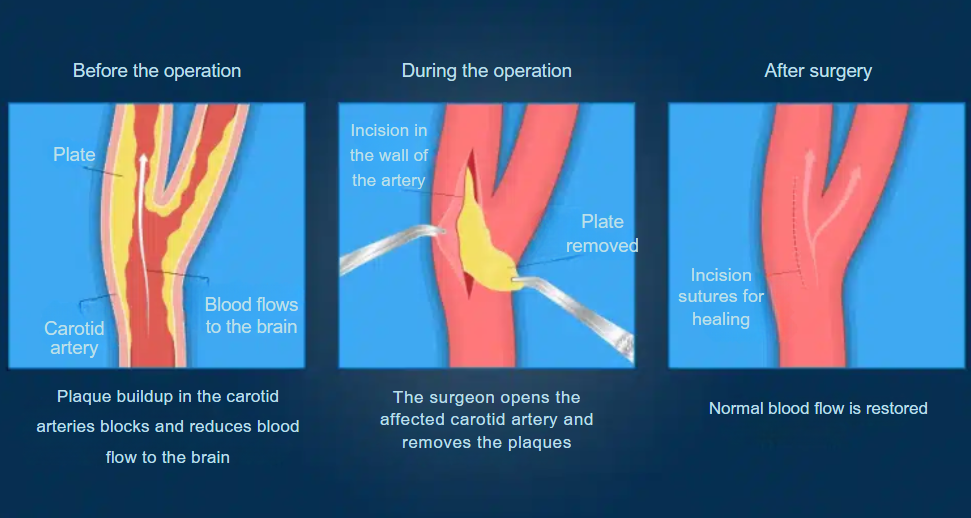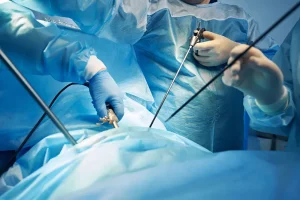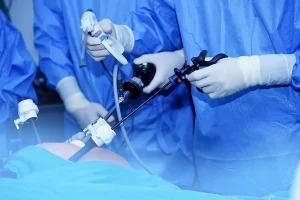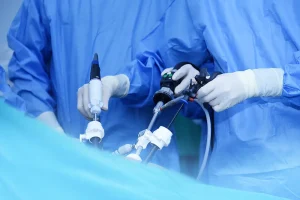Everything you need to know about carotid endarterectomy
- Medically checked
Home » Everything you need to know about carotid surgery
Medical Procedures
Vascular Techniques
Endovascular Techniques
Conditions Treated

The carotid arteries, essential for supplying oxygenated blood to the brain, can become blocked, increasing the risk of stroke. Carotid artery surgery is a key intervention to clear these blockages. It is vital to recognize the symptoms of carotid disease, such as slurred speech or numbness, in order to act quickly.
To prevent stroke, maintaining a healthy lifestyle is essential. In select cases, carotid stenting offers a minimally invasive alternative to traditional vascular surgery, keeping the arteries open and ensuring blood flow to the brain.
Carotid artery blockages can reduce blood flow to the brain. They are caused by a buildup of plaque, made up of fat, cholesterol and calcium. This buildup narrows the artery, a process called stenosis.
The plaque can break off, blocking the smaller arteries in the brain. This can lead to embolism or even stroke if the narrowing is major.
What is a carotid endarterectomy?
If the carotid artery is narrowed or blocked, your doctor may perform a carotid endarterectomy, also known as carotid artery surgery. This procedure removes blockages, ensuring normal blood flow.
This reduces the risk of stroke. In addition, carotid artery surgery prevents transient ischemic attacks (TIAs), which are stroke-like but temporary. The operation therefore maintains blood flow to the brain, thus preventing strokes.
When is carotid endarterectomy recommended?
Your doctor may recommend carotid surgery if you meet certain criteria:
- You have already had a stroke
- You have already had a TIA
- Carotid artery blockage is severe (>70%) but not complete
Preparing for carotid surgery
Before the operation, your doctor will perform a few tests to see exactly what the condition of your arteries is, including.
What happens during carotid artery surgery?
You will be admitted to hospital for carotid surgery, which lasts several hours. Under general anesthesia, the surgeon will open the artery and remove the blockage. If necessary, local anesthesia may be used to numb the area of the neck where the operation is done.
To clear the artery, the blood flow will be temporarily stopped. No need to worry, as the blood will flow through the other carotid artery. A special tube may be used to redirect the blood during the operation.
After removing the blockage, the surgeon will sew the artery. The incision will be closed with stitches. These steps ensure that the procedure is safe and effective.

Surgery for a clogged carotid artery
Recovery after carotid artery surgery
After carotid endarterectomy, you must stay in the hospital for 24 hours. This allows the doctor to check that everything went as expected. This ensures that there is no bleeding or other problems that could affect blood flow to the brain. This helps prevent the risk of a stroke.
In the days following surgery, you may feel discomfort. This may include pain, numbness, swelling or bruising in the neck area. If you have difficulty swallowing, it is important to talk to your doctor. He or she will recommend appropriate treatment.
You should avoid physical exertion, such as lifting heavy objects or driving, for up to two weeks after surgery. Your doctor will tell you when you should resume your normal activities. Following these guidelines is vital for an optimal recovery.
CEA, a safe procedure
CEA is considered a safe procedure that can greatly reduce the risk of stroke if you have carotid artery disease.
Alternatives to carotid surgery - Carotid stent
Carotid stenting is another surgical alternative to a CEA. During this carotid stent procedure, a thin cylindrical metal mesh called a stent is inserted into the artery, and the mesh is inflated with a balloon to keep the artery open.
But your doctor will tell you exactly which procedure is right for you.
Learn more about carotid stenting here.
Can carotid artery disease be prevented?
To minimize the risk of developing carotid artery disease and prevent stroke, it is essential to recognize the symptoms of carotid artery disease and adopt a healthy lifestyle. Monitoring the condition of the carotid arteries and regular consultation with a specialist can be decisive. There are various measures you can take to reduce your chances, including: quitting smoking, limiting cholesterol and fat, exercising, reducing alcohol consumption, maintaining an optimal weight.
We recommend regular visits to your doctor for advice on how to maintain your heart and blood vessel health.
If you identify symptoms of carotid disease or if you are looking for effective ways to prevent stroke, our team at VenArt Clinic is ready to offer you personalized solutions.
Why choose VenArt Clinic for carotid artery surgery?
At Clinica VenArt, we are experts in carotid endarterectomy and carotid stenting, our doctors have decades of experience and have specialized in renowned clinics in Europe and the USA.
If carotid artery surgery is not the best option for you, we will recommend other treatments more suited to your individual circumstances.
If you would like a consultation, do not hesitate to contact us.
Medical Consultant: Prof. Dr. Jérôme Cau








